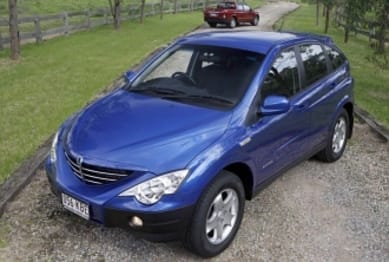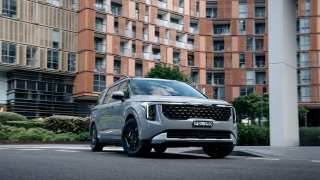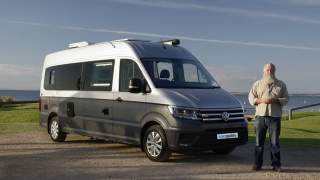
Ssangyong Actyon and Actyon Sports 2007 review
- Ssangyong Actyon
- Ssangyong Actyon Sports
- Ssangyong Actyon 2007
- Ssangyong Actyon Sports 2007
- Ssangyong Actyon Reviews
- Ssangyong Actyon Sports Reviews
- Ssangyong Reviews
- Ssangyong Sedan Range
- Ssangyong SUV Range
- Ssangyong Ute Range
- Commercial
- Sedan
- SUV
- Ute
- Ssangyong
- Family Cars

The Korean Actyon and the Actyon Sports — the differences are largely confined to the chassis length and the bodystyles — arrive at a reasonable price into two market segments that continue to grow.
Both are offered with petrol or diesel engines, manual or automatic transmissions; both have two trim levels and the Actyon Sports ute is also available in two-wheel drive.
Both have fabulous noses, shark-like character lines from the windscreen forward. Until the B-pillar (the one behind the front seats) the shorter Actyon hatchback and the Actyon Sports share exterior style and cabin detail.
Then the Actyon turns into a bob-tailed, four-door hatchback and the other into a useful four-door ute.
Most mechanicals are shared, apart from a 320mm shorter driveline on the Actyon, which sits at 4455mm in body length compared with the Actyon Sports' 4965mm.
And for much of the driving experience the pair are quite similar, in particular here with diesel-automatic versions of the Ssangyong siblings driven back-to-back.
Maybe the hatchback rides a touch tauter and quieter, maybe it sits a bit taller on the road yet otherwise the results are much the same. Here is a pair of Koreans with a fresh (some think too fresh) approach to style, reasonable build quality and sturdiness plus decent pricing. The style polarises opinion.
The Actyon, up against the likes of Toyota's RAV4, Nissan X-Trail and Honda CR-V, looks like a Dakar racer. It sits tall and squat with a little bit of crouch on 18-inch alloy wheels. The hatchback style is unusual in this part of the market and indeed that falling-away roof line at the rear cuts into luggage space (especially when the Actyon's rear floor sits so high). So perhaps it loses a little here against the rivals which generally arrive in conventional wagon styles, albeit with a few curves and swoops.
But before the tyrekickers start taking aim at the Actyon's unusual style, take a quick look at the Audi concept coupe (possibly pointing to a forthcoming Q3 or Q5?) shown at the Shanghai motor show earlier this year. If it's OK for Audi to play with this school of thought the Ssangyong crew may just be running ahead of the pack.
The Actyon Sports ute of course shares the same frontal treatment as the hatchback, apart from the material filling in the grille opening. The ute's looks are welcomed in this segment where there's been little adventure in style for some time (though the current Mitsubishi Triton has lifted the bar.)
Unlike the Actyon, the Actyon Sports has a very useful tray area out back. It is not overlong at 1275mm but there is decent width at 1610mm and depth of 540mm.
Some of the cabin details in this pair lack a bit of fit and finish but layout and design work well.
Again, the front cabin of both Actyon and Actyon Sports are the same. There are the three big instruments — speedometer, tachometer plus the collected fuel and temperature gauges — in front of a steering wheel with audio controls. The rest of the controls, including a dashboard knob to shift into four-high and four-low, are all logical and easy to find, even if the tactile experience isn't always up there with Japanese rivals.
Strange too that the shift-gate for the auto transmission can be a little awkward when the design is lifted from older Mercedes-Benz.
There is, even in standard models, the usual array of comfort and convenience features including air conditioning and CD/stereo. ABS is standard on Limited models, driver and passenger airbags are standard across the range, but only the Limited version of the Actyon scores electronic stability program, brake assists and traction control.
Back seat space is better in the Actyon than the Actyon Sports. Here the ute loses out a bit over the competition from the Toyota HiLux, Nissan Navara and Mitsubishi Triton. But remember the price savings over comparable Japanese rivals.
The Actyon Sports is the follow-up to the Ssangyong Musso Sports, a reliable hauler. There are improvements in ride, steering and general handling dynamic and the new machine remains a reasonable off-roader for light to medium duties.
There wasn't a chance this time round to give the stubbier Actyon a serious off-road workout, but the general specifications and those good approach and departure angles, suggest the little Musso will outdo compact rivals in this area.
The standard four-wheel-drive Actyon Sports is let down to some extent by the 16-inch, 225/75 Kuhmo tyres. These may lose traction at small provocations, detracting from what's not a bad chassis.
The smaller Actyon, riding on more rubber, is that much quieter and more confident when the road surface becomes trickier.
But both diesel-powered Ssangyongs have one annoying trait — that's the turbocharged, four-cylinder engine finding its get-up-and-go somewhere the other side of 2000rpm.
In the Actyon this can lead to a great gob of torque locking up the rear wheels as the machine moves off; in the Actyon Sports it's more a little bunny-hop.
Now the engine — traced back to a Benz design, is a good worker, putting out 104kW at 4000 rpm and a claimed 310Nm of torque at 1800rpm. It is just that tad sluggish off the mark, convincing a driver the best method of dealing with the cut and thrust of traffic is to bury the right foot. This tardiness (compared with rivals) may also raise its head on the highway though the engine is far more flexible once running beyond 2000rpm.
For both diesels Ssangyong suggests fuel consumption should be just under 9l/100km and that would appear a fair call.
And that diesel option is one advantage the Actyon hatch has over some rivals in the compact herd. Other diesel options here include the Jeep Compass, Hyundai's Santa Fe and the forthcoming Land Rover Freelander II.
Ssangyong Australia reckon customers for the Actyon will be females between 25 and 39 years old with good incomes or young couples with maybe one child. These are people who want to make a statement, says Ssangyong Australia's marketing manager Brad Larkham.
The Actyon Sports should appeal across a wider spectrum, from traditional tradespeople to “white-collar” tradesmen, the likes of engineers and surveyors.
There is no doubt there's been some effort put into both these machines. Where they may not always match Japanese rivals, the prices are right for the Ssangyong Actyon duo to find their own little niches.
Ssangyong Actyon Sports
$34,990
Body: four-door utility
Engine: 2-litre, turbocharged diesel
Power: 104kW @ 4000rpm
Torque: 310Nm @ 1800rpm
Transmission: part-time 4WD/four-speed auto
Dimensions (MM): 4965 (l) 1900 (w) 1755 (h) 3060 (w'base)
Weight: from 1803kgTOWING: 2300kg (braked)
Ssangyong Actyon
$35,990
Body: five-door hatchback
Engine: 2-litre turbocharged diesel
Power: 104kW @ 4000rpm
Torque: 310Nm @ 1800rpm
Transmission: part-time 4WD/ four-speed auto
Dimensions (MM): 4455 (L) 1880 (W) 1745 (H) 2740 (w'base)
Weight: from 1870kg
Towing: 2300kg (braked)
Pricing guides
Range and Specs
| Vehicle | Specs | Price* | |
|---|---|---|---|
| A230 | 2.3L, ULP, 4 SP AUTO | $2,200 – 3,410 | 2007 Ssangyong Actyon 2007 A230 Pricing and Specs |
| A200 XDi | 2.0L, Diesel, 5 SP MAN | $2,040 – 3,190 | 2007 Ssangyong Actyon 2007 A200 XDi Pricing and Specs |
| A230 Limited | 2.3L, ULP, 5 SP MAN | $2,530 – 3,960 | 2007 Ssangyong Actyon 2007 A230 Limited Pricing and Specs |
$2,040
Lowest price, based on third party pricing data







